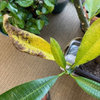is my Adenium Obesum on it's way out??
greenclaws UK, Zone 8a
16 years ago
More Discussions
My little 6inch DR's stem has one soft, I thought something was amiss a few days ago as it wasn't as firm as it had been.
Having un-potted it today I find the base of the caudex had rotted and there were hardly any roots attached to the plant, but lots in the compost! It's still in full leaf and growing with no leaf drop or dormancy showing. The bottom of the caudex has a few new root nubs sprouting. Can it be saved?
The original compost was sharp grit, perlite and regular compost in equal amounts and it's been re-potted today in a similar mix. It had been watered now and then as it was still growing and leafy but it never stands in water. What do I do now? It has been living on top of the tropical fishtank to keep it nice and warm, but it dries the compost out, so it gets watered. Oh dear, what have I done to it!? Obviously its been overwatered at some point, but will it pull through? What does anyone advise? Look for some more seeds I hear you all shout!! S-s-s-s-somebody help me!
Gill, aka the Adenium killer : (

kimisdad
greenclaws UK, Zone 8aOriginal Author
Related Professionals
Canby Landscape Contractors · Coram Landscape Contractors · Edinburg Landscape Contractors · Manhattan Landscape Contractors · Middletown Landscape Contractors · Northport Landscape Contractors · Ocoee Landscape Contractors · Peoria Landscape Contractors · Pleasant Hill Landscape Contractors · Watertown Landscape Contractors · Norridge Landscape Contractors · Lafayette Siding & Exteriors · Paterson Siding & Exteriors · Saint Charles Siding & Exteriors · Wareham Siding & Exteriorskimisdad
greenclaws UK, Zone 8aOriginal Author
Dave in NoVA • N. Virginia • zone 7A
greenclaws UK, Zone 8aOriginal Author
littlem_2007
greenclaws UK, Zone 8aOriginal Author
xerophyte NYC
greenclaws UK, Zone 8aOriginal Author
kare4plumies
kimisdad
greenclaws UK, Zone 8aOriginal Author
xerophyte NYC
greenclaws UK, Zone 8aOriginal Author
kimisdad
kimisdad
xerophyte NYC
kimisdad
xerophyte NYC
xerophyte NYC
greenclaws UK, Zone 8aOriginal Author